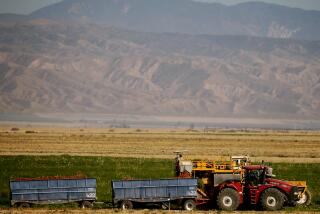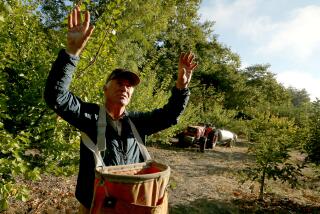Water cuts taking a slice out of avocado groves
FALLBROOK, CALIF. -- — Deep in the green avocado groves, the winter quiet is shattered by the whine of chain saws. Workers wielding machetes slash leafy branches from the trees and spray-paint the tall stumps white to protect the bark from sunburn in the forced hibernation to come.
Here, in the heart of the nation’s avocado industry, growers are beheading their avocado trees.
Less than two months after a mandatory 30% cutback in agricultural water deliveries, some Southern California growers have begun “stumping” hundreds of healthy, well-nurtured avocado trees, putting them out of production for the next one to three years to leave more water for the rest of their trees.
Their actions represent the downside of a water deal between area farmers and the region’s water wholesaler, the Metropolitan Water District. Over the years, thousands of farmers signed up for a program that gave them discounted water in return for their willingness to be first in line for a water cutback.
This winter is payback time.
For the first time since the program started in 1995, farmers must reciprocate for years of discounts. The MWD cut their water deliveries by 30% on Jan. 1 because of the regional shortage caused by last year’s record dry weather, an eight-year drought in the Colorado River Basin and a court order protecting the endangered smelt in the San Joaquin-Sacramento River Delta.
Even though this season’s rainfall to date is above normal, with the most recent storm dousing Southern California this weekend, farmers say the wet weather is only postponing the inevitable. Come the dry months of summer, they still will have 30% less water to nurture their crops.
From Ventura to the Mexican border, farmers are rethinking their crop plans and curtailing spring plantings of pumpkins, potatoes and watermelons. Some citrus growers said they will have to remove trees to save water. Those using too much could be fined thousands of dollars and have locks installed on their water meters.
“There is a lot of anxiety and angst out there,” said Rex Laird, chief executive of the Farm Bureau of Ventura County. “Water is not something you can skimp on. Plants either get what they need, or they die.”
Most farmers in the six-county MWD service area are subject to the cutback, including 5,000 in San Diego County alone, according to the county water authority. The county is the nation’s largest avocado supplier.
By idling parts of their groves, growers can fully irrigate remaining trees to produce the heavy, plump, well-nourished avocados prized by shoppers nationwide.
Avocados cost about $1.50 each, and though prices may increase in time, the more immediate effect will be fewer California avocados in 2009 and smaller incomes for farmers in this verdant, orchard-studded valley.
Most farms flanking Fallbrook’s winding roads are 10 acres or smaller. Many are owned by families whose finances are less stable than those of large corporate farms. Some probably will go under, farmers said. Maybe they bought overpriced land 10 years ago and already are struggling to meet their debt payments.
“You pray it’s not going to be the case, but there are some that are on the edge,” said Guy Whitney, industry affairs director at the California Avocado Commission.
Residents fear that the hillside orchards will be replaced by more residential projects like the ones closer to town, with agrarian names such as Sycamore Ranch and Shady Grove.
Farmers say they’re protecting their investment when they stump their orchards. “The tree would be hurt more having water cut back than if you cut it down and shut the water off,” said Charley Wolk, 71, a prominent farmer who has grown avocados here for half his life. He owns his own groves, and his management firm, the Bejoca Co., oversees hundreds of acres of other owners’ avocado trees. So far, he’s stumped 1,000 trees.
Wolk is matter-of-fact about the cutback, saying that the MWD gave farmers plenty of notice before reducing deliveries. Still, he is grappling with tough decisions about how best to tend to his trees.
He pointed to the ceiling of his office. “Where do I go with a tree that’s as high as that beam?”
He held his hand 4 feet off the floor. “What about trees this high, maybe 3 years old?” He has a number of 3-year-old trees growing on a hill, and he thinks he’s figured out a fix: He’ll irrigate less often at the bottom of the hill, since moisture from above should keep the soil damp.
The tree-cutting comes as residents in Los Angeles, San Diego and most other area cities are still getting 100% of the water they need, with most of it going for lawns and landscaping.
“People need to know that in Southern California, water is a precious resource. But they’d rather water their lawns and cut off the farmers,” said Laura Blank, executive director of the Los Angeles County Farm Bureau.
The state agriculture industry is often criticized by environmentalists, who say that it wastes water and raises moisture-hungry crops such as rice and cotton. Several Fallbrook-area farmers, however, say they have worked for years to reduce consumption.
Carl and Ed Kessel, who are tending 3,100 lemon trees on their Fallbrook farm, added water-stingy flow devices to their computerized irrigation system and installed 28 moisture sensors, hoping to reduce water use by 50%.
January meter readings showed that Fallbrook-area farmers reduced their use by 85% from the dry January last year. Still, Keith L. Lewinger, general manager of the Fallbrook Public Utility District, had to start making calls to customers using the most water.
“Some of them said, ‘I had a broken pipe,’ ” he said. He warned they would be fined $2.51 per 1,000 gallons, or nearly twice the regular rate of $1.36. If they fail to make a 30% cut two months in a row, the district will install a meter flow restricter, a washer-like device that reduces water delivery.
“If push comes to shove,” Lewinger said, “we can shut the meter off.”
Lewinger said he has no extra water to give them. If every farmer in town were to exceed the water limits by 10% for the year, the Fallbrook district would owe the MWD $609,000 in penalties, he said.
The MWD board of directors is expected to discuss the future of the 14-year-old agricultural water program at its May meeting, amid criticism from some urban water districts that farmers should not be receiving discounted water during a shortage.
Whatever the outcome, farmers must still grapple with water cutbacks that could grow more severe if the shortage worsens or if the courts further reduce delta deliveries. If the MWD were to cut water to its urban users by 15%, farmers’ deliveries would be cut by 40% under a drought plan approved two weeks ago. If urban users see a 35% reduction, deliveries to farmers would be halted altogether.
Bob Polito, 57, who grows oranges in Valley Center, near Fallbrook, plans to take down as many as 1,500 trees, many with unripened fruit still on them. He has not started the work.
“I think I’m waiting until the last minute,” he said last week. “You have these trees you’ve been raising for 40 years, and now I’m going to lose both the crop and the trees.”
Polito sells oranges, tangerines and lemons at the Santa Monica Farmers’ Market and other area markets, where many shoppers haven’t heard of the 30% cutback.
That does not surprise him, since the water crunch is not being felt in the city, he said. “As long as they have enough water to put on their lawn and wash their dishes, they’re happy.”
--
More to Read
Sign up for Essential California
The most important California stories and recommendations in your inbox every morning.
You may occasionally receive promotional content from the Los Angeles Times.










